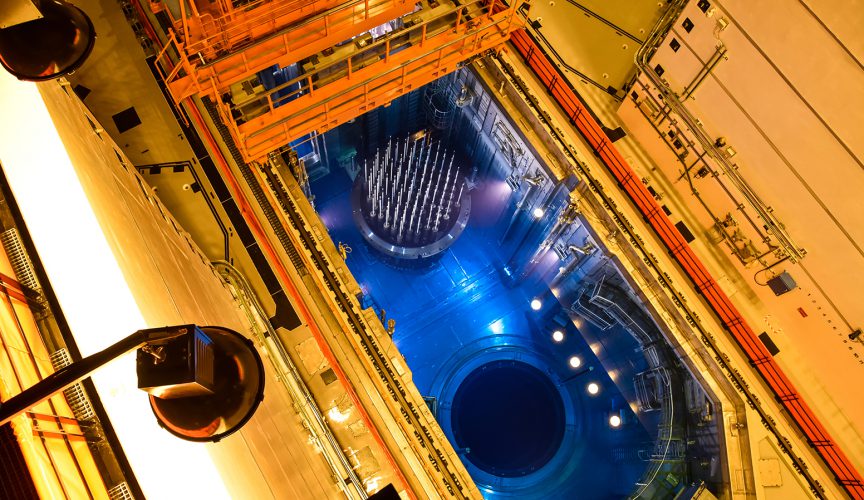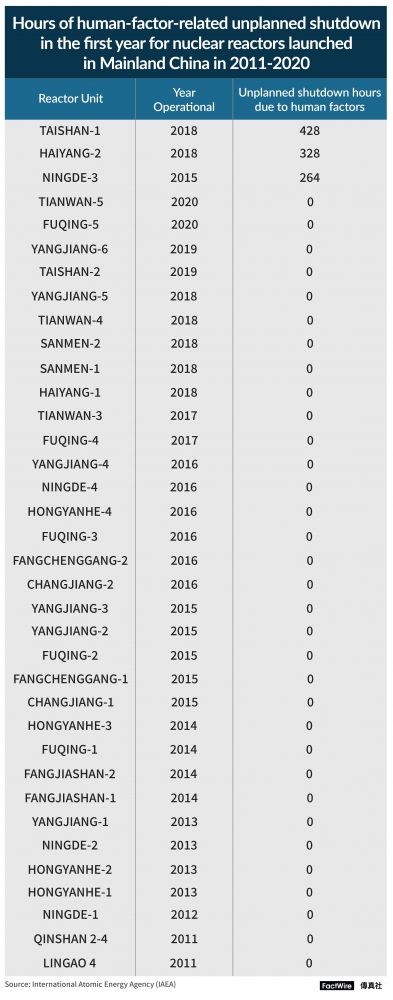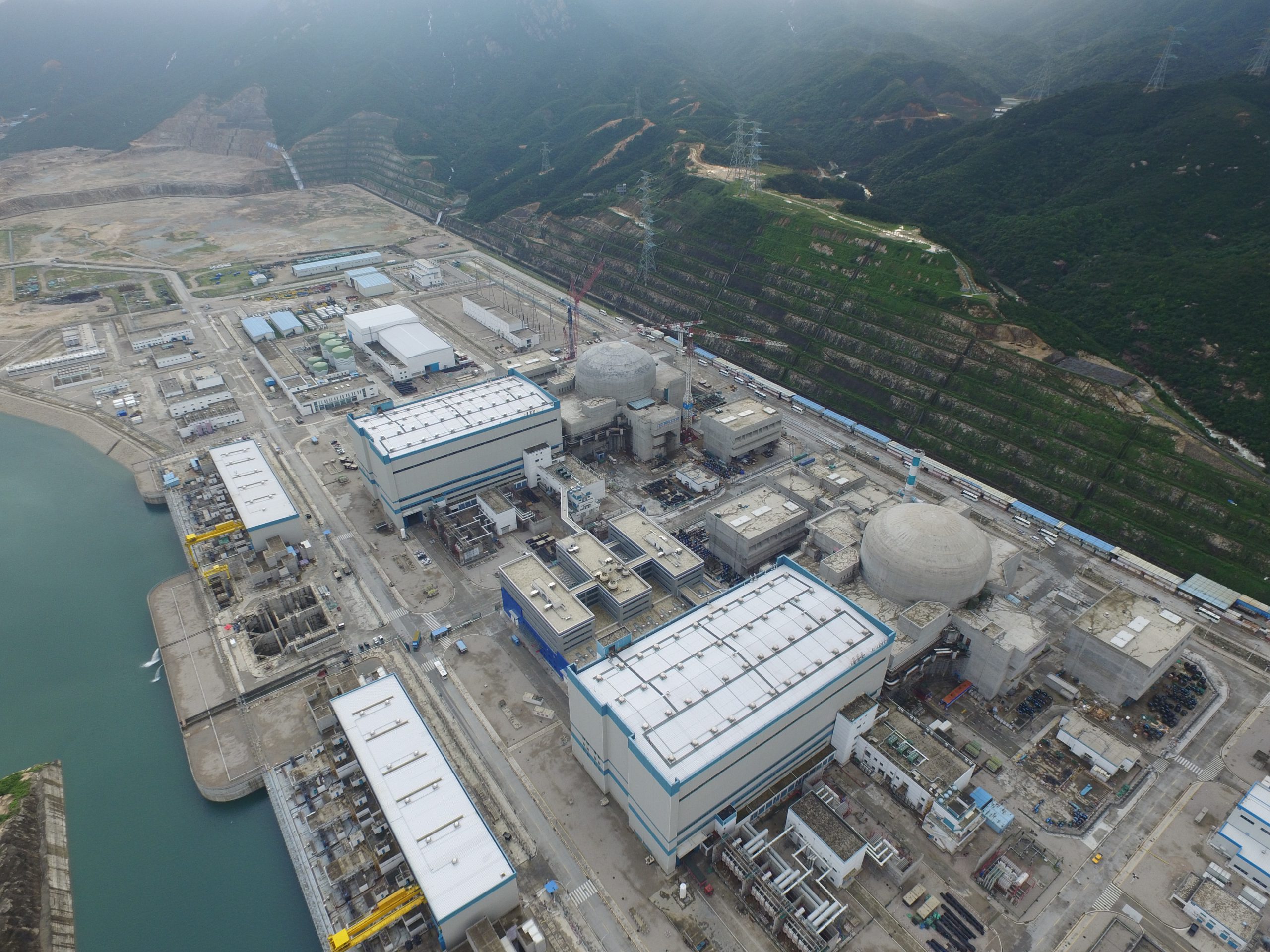Records reveal that Unit 1 of Taishan Nuclear Plant experienced 428 hours of unplanned shutdowns in relation to ‘human factors’ within its first year of operation in 2018, a record high amongst Mainland China’s nuclear reactors that began operating in the past decade. An expert says this may reflect a lack of worker training.

Records reveal that Unit 1 of Taishan Nuclear Plant experienced 428 hours of unplanned shutdowns in relation to ‘human factors’ within its first year of operation in 2018, a record high amongst Mainland China’s nuclear reactors that began operating in the past decade. An expert says this may reflect a lack of worker training.
In June this year, CNN reported an “imminent radiological threat” from Taishan Unit 1. Électricité de France (EDF), which holds a 30% share of the plant, confirmed a rise in the levels of noble gasses in the primary circuit of the reactor, potentially caused by a “degradation of the housing of the fuel rods”. In addition to reaching out for help from the United States Department of Energy, the French company issued a statement on July 22 recommending a shutdown for Unit 1 in order to accurately assess the situation.
An announcement made on September 30 this year by CGN Power Co., Ltd (1816.HK), the majority owner of the plant (at 70% stake), confirmed that a shutdown had been initiated at Taishan Unit 1 on July 30, 2021 to ‘find out the cause of, and to replace, defective fuel rods’. Inspection and maintenance was in progress at the time of the announcement.
No plans to relaunch the reactor were mentioned in the latest announcement made by CGN, following an extraordinary general meeting held last Wednesday (October 27) in Shenzhen. Details of the inspection and maintenance were also not found on the National Nuclear Safety Administration (NNSA) website at the time of writing.
This is not the first unplanned shutdown for Taishan Unit 1. The International Atomic Energy Agency (IAEA)’s annual reports on nuclear power station operation in OPEX member states show a total of 428 hours of unplanned full outages related to “human factors” in 2018.
Out of 36 nuclear reactors that began operating in Mainland China in the past decade (2011 to 2020), three were found to have had unplanned full outages due to human factors within their first years of operation.
Taishan Unit 1, Haiyang Unit 2 and Ningde Unit 3 were shut down for 428 hours, 328 hours and 264 hours respectively. The remaining 33 reactors had no unplanned full outages caused by human factors in their entire first years of operation.
The data listed in OPEX reports is submitted by respective member states and each reactor’s data analysts. IAEA only publishes the report annually, and is not responsible for revising the data.
The data submitted by Mainland China is based on shutdowns that occurred after their reactors had achieved criticality – that is, the state of maintaining a self-sustaining nuclear chain reaction – usually some months before commercial operation started. Comparisons could not be made with reactors of other countries since their data prior to commercial operation is not available in OPEX reports.
According to OPEX definitions, both power reduction and unit shutdown are considered outages. An outage is ‘unplanned’ if it is not scheduled at least four weeks in advance. OPEX also specifies that the outage is significant if it is caused by an unplanned reactor scram (an emergency shutdown procedure whereby fission reactions are terminated), regardless of the duration.
Taishan Unit 1’s unplanned shutdown in July this year is yet to be reflected in the latest OPEX report, and details of the ‘human factors’ that caused the unplanned shutdown in 2018 have not been made available in past OPEX reports.
Taishan Unit 1 achieved criticality in June 2018 and was put into commercial operation in December 2018. According to NNSA’s 2018 annual report, there had been 12 operational incidents for Unit 1: five arising from “human factors”, six arising from the facility itself, and one arising from managerial issues.
Among the five incidents arising from human factors, three led to automatic reactor scrams. They were caused by accidental contact with the electrical relay, over-pressurisation of the steam generator, and high water levels in the steam generator respectively. The only management-related issue was an incidence of noncompliance with the power station’s technical standards.
Two incidents concerning Haiyang Unit 2 arising from ‘human factors’ are listed in NNSA’s 2018 annual report, one of which was a loss of water supply that resulted in a manual reactor scram . As for Ningde Unit 3, NNSA’s 2015 annual report shows four incidents caused by ‘human factors’, for which two led to reactor scrams in April and June 2015 respectively.
Another report by the NNSA reveals that Taishan Unit 1 had been asked to reexamine and improve upon its proposed fuelling procedures in December 2017, around four months prior to any fuel being first introduced to Unit 1. Procedures recommended include clarifying the division of labour concerning fuel-loading, and completing training and authorisation of the plant’s workers based on an updated version of technical specifications before the plant’s first fuel-loading.
Chairman of the Hong Kong Nuclear Society Dr. Luk Bing-lam pointed out that long hours of unplanned shutdown relating to human factors reflects a possible lack of training for the workers, since beginners who are unfamiliar with the operation may easily cause an automatic scram. “If unplanned shutdowns due to human factors happen frequently, either the training for the workers has to be reviewed, or appraisal standards for them have to be raised,” he said.
Luk added that training for the workers is important for both new digital reactors and traditional analog reactors (like the Daya Bay Nuclear Plant, first operational in 1994), in order to make sure that workers are familiar with operational procedures.
In a prior interview with Xinhua News Agency, Qiao Sukai, a senior engineer specialising in fuel-loading, said that four to five years of training are required for an operator in the control room to qualify for the position, and seven years for a senior operator. According to the NNSA’s 2018 annual report, there were 68 operators and 42 senior operators in total at Taishan Nuclear Plant Units 1 and 2.
FactWire posed a number of questions to CGN –
Were “human factors” implicated in Taishan Unit 1’s fuel rod damage? Were fuel-loading personnel implicated in Taishan Unit 1’s fuel rod damage? What (if any) progress has been made on repairs? How many fuel rods are damaged? Why has there been no news since the shutdown three months ago? How much (if any) leakage has there been of noble gases and radioactive material?
– but has, at the time of writing, yet to receive a response.
An announcement by CGN dated September 30, 2021 stated that Taishan Unit 2, which adopted the same design and fuel type as Unit 1, has been “operating steadily, with all operational indicators meeting the requirements of both nuclear safety regulations and technology standards of nuclear power plants.”
OPEX reports have not recorded any human-factor-related unplanned full outages for Taishan Unit 2 since it began operating in 2019, although three operational incidents caused by human factors are listed in the NNSA’s 2020 annual report.
The IAEA’s report on “Human and Organizational Factors in Nuclear Safety in the Light of the Accident at the Fukushima Daiichi Nuclear Power Plant”, published in 2013, illustrates the risks attributable to “human factors” in the operation of nuclear power plants. It says that, “the importance of human factors in nuclear safety was highlighted by the Three Mile Island accident in 1979 that led the nuclear community to acknowledge the role of non-technical aspects of nuclear operations.” It also quotes an International Nuclear Safety Advisory Group comment on the Chernobyl disaster in 1986, saying “the root cause of the Chernobyl accident, it is concluded, is to be found in the so-called human element.” It also quotes the National Diet of Japan’s report on the Fukushima Daiichi accident in 2011, saying that “the accident should not be considered solely the result of extreme natural events but also as a human-induced accident that was, at least in part, preventable.”
In June 2020, the IAEA released nuclear power plant data for 2019 collected by the Power Reactor Information System (PRIS), revealing a gradual reduction in the number of unplanned scrams or shutdowns. “The reduction in the number of unplanned scrams indicator [sic] is attributed to continued successful plant operations and maintenance management,” reads the press release.
The effect of unplanned shutdowns can be glimpsed from a document titled “Safety Aspects of Unplanned Shutdowns and Trips” published in 1986 by IAEA, where it says reducing the frequency of forced shutdowns will “have safety benefits in terms of reducing the frequency of plant transients and the challenges to the safety systems, and the risks of possible incidents.”
FactWire published a series of reports from 2016 to 2018 regarding safety concerns over Taishan Nuclear Power Plant, which include an abnormal amount of carbon detected in the top and bottom of the reactor’s vessel, risking cracks during fission reactions, which could result in fuel rods melting in the reactor core and the leakage of radiation. The vessel is still set to remain in use until April 2025, three years and five months from now. In 2017, CGN admitted a “partial defect” of Taishan Unit 1’s deaerator, following FactWire’s revelation that the key component cracked during performance tests.



